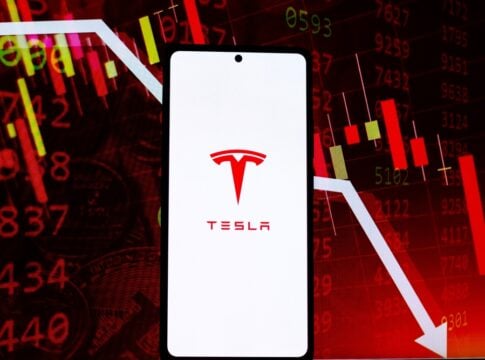Friction from the West is Loosening China’s Grip on Rare Earths Elements
As the world grapples with the urgent need for decarbonization to combat climate change, China’s top position in the production of rare earth elements (REEs) and its growing influence in the carbon credit market have had profound implications for the global energy transition
China currently dominates the market supplying over 80% of the world’s rare earth elements. Considered a monopoly in most political circles, its prominent position has raised concerns among many nations about the vulnerability of their supply chains and the geopolitical implications. But is this tension a sign of possibile future supply limitations that pose a threat to the decarbonized future?
REEs are a set of 17 metallic elements with unique electrical and magnetic properties, playing a crucial role in the mineral supply chain market. Their applications range from magnets powering electric vehicles (EVs) and wind turbines to defense systems using precision missiles, fighter jets, and submarines, energy-efficient lighting systems etc.
All these factors come down to one thing: green energy transition, because:
China leads the production of key materials for EV batteries, refining 68% of the world’s cobalt, 65% of nickel, and 60% of lithium meeting the required grade. Additionally, it holds a significant share of ~ 75% of EV batteries, and the majority of them are manufactured in China.
China maintains its position in the rare earth industry due to its comprehensive control over the entire production chain and a substantial scale in the world economies. China’s advantages extend from mining raw materials to producing high-purity rare earths, facilitated by a cost-effective labor force.
Is this enough to sustain China’s dominance in the long run? It’s indeed a matter of concern and the answer is that there are numerous loopholes in marketing strategies, political scenarios, and supply chain management.
Interdependence of global decarbonization goals and China’s REEs
The concentration of REEs in China raise concerns worldwide. Although, the US Department of Energy once said:
“the US decarbonization goals are reliant on both Chinese firms and the Chinese government”
Yet the current geopolitical scenario is slightly different. The prime issue is that no matter where the REEs are mined, they need to undergo processing in China. This grants China substantial influence over various supply chains. But in this ESG-conscious era, investors, suppliers, and consumers must be more aware of the environmental effects of their purchases.
The extraction of rare earth minerals is a complex process and has raised serious climatic concerns. A study from the Harvard International Review stated,
“Mining to produce one ton of rare earth elements results in nearly 30 pounds of dust, 9,600-12,000 cubic meters of waste gas including substances such as hydrofluoric acid and sulfur dioxide, 75 cubic meters of wastewater, and one ton of radioactive residue—2,000 tons of toxic waste altogether.”
The report also mentioned that the world’s largest rare earth element mine, Bayan-Obo in China, produced over 70,000 tons of radioactive thorium waste which is stored in a tailing pond that has leaked into groundwater.
China, being the prime market for REEs must adopt ways to make large-scale mining more sustainable and greener. Some latest technologies include:
- Electrokinetic method is used by many Chinese companies to improve the leaching process and quantity of the extracted minerals. It’s mostly suitable for heavy REE with high atomic numbers like dysprosium and terbium.
- Biomining is a highly sustainable process that incorporates microbes to do the leaching process. One such species is the cyanobacteria- it produces organic acid to extract the REE from recycled e-waste, ores, and wastewater.
- Agromining – the process incorporates plants that have hyperaccumulation and rapid-growth capacity on REE-rich soil. Researchers say agromining works most efficiently for nickel.
However, all the sustainable alternatives mentioned above are yet to be examined deeply considering their practical values and cost effectiveness.
We can infer that China to remain in the top position in the carbon market and REEs, must operate in socially and environmentally responsible ways. The country further needs to ensure transparent supply chains free from human rights infringement and environmental damage.
READ MORE : China’s CO2 Emissions Up 4% in Q1 2023, Hit a Record High
On the other hand, the West is putting serious efforts to decrease dependence on China for rare earth mineral supply. They are exploring technologies to replace REEs or use fewer REEs.
For example, Tesla recently announced plans for next-generation motors using rare earths-free magnets. There’s a mixed review of this move. While some industry pundits say it would have minimal effect on the market because they believe EVs without rare earth will have a very low success rate. While others consider this to be a revolutionary move. It is further predicted that production of EVs in the coming years won’t experience a slump if they become independent of rare earth minerals. This in turn will directly push the carbon market and mitigate carbon dioxide emissions.

These are just some of the factors responsible for REE’s geopolitical conundrum and have given rise to an important question – does a fair trade agreement exist between China and the West over rare earth elements?
Will Friction from the West Loosen China’s Grip on REEs?
The US and Europe have shaken hands and signed deals without China. President Biden and his allies prioritize technology and green energy, while Global South nations, like India, push for EV adoption to boost energy independence.
One notable collaboration involves US and European rare earth companies processing monazite sands in Utah, followed by shipping rare earth carbonates to Estonia for further refinement.
In recent news, the United States Department of Defense (DoD) granted a $120 million contract to Australia’s Lynas Rare Earths to construct a heavy rare earths separation facility in Texas. Lynas USA LLC, a subsidiary of Lynas Rare Earths Ltd, will own and operate this facility. The objective of the contract is to bolster domestic industrial capacities for heavy rare earth elements (HREEs), involving metals like gadolinium, dysprosium, and ytterbium.
Japan has also fortified its rare earth supply chain by increasing investments in Lynas, securing a steady supply of heavy rare earths. According to UN Comtrade data, Japan has succeeded in this strategic move to decrease its rare earth dependence on China from over 90% to 58% within a decade.

Source: elements.visualcapitalist.com
The graph above showcases China’s share of global production of REE market is expected to go down from 92% in 2010 to 58% in 2020.
Despite the solid efforts put in by the US, Europe, and Japan, China continues to defend its monopoly. It has aggressively expanded its international market by acquiring stakes in some of the largest mining companies like MP Materials (US) and Vital’s Metals (Australia).
China’s tax system and production quota are highly meticulous. It has imposed 13% VAT on magnets, metals, and oxides. Simply put, domestic rare earth product manufacturers have a 13 % cost advantage in the supply chain over foreign competitors. Thus, if countries decide to diversify their rare earth supply chains away from China, it could result in increased costs for those nations.
Will this Geopolitical Tension be a Roadblock to the Green Energy Transition?
A survey conducted by The Oregon Group, explains that 2024 is expected to witness persistent volatility and surged prices in major commodities and rare earth minerals. Contributing factors are:
- supply constraints
- geopolitical tensions
- long-term underinvestment
This economic contraction particularly in the US and China can potentially supress demand and supply, especially in the critical mineral sector. It’s foreseeable that in the current year and beyond, a distinct divergence in critical mineral prices between Western nations and China may not manifest. And this leads one to the conclusion that if geopolitical tensions and inefficient strategic planning persist between the leading economies of the world, then energy transition goals for sustainable low-carbon future are most likely to get hindered.
The post China’s Grip On Rare Earth Elements Loosens appeared first on Carbon Credits.
Carbon Footprint
Tesla (TSLA) Stock Slips After Q3 Results as Carbon Credit Revenue Plunges 44%
Tesla today released its third-quarter 2025 results. The company posted $28.1 billion in revenue, up 12 % compared with a year ago. Net income narrowed sharply to $1.4 billion, down roughly 37 % from the same quarter in 2024. The gross margin stood at about 18 %, down from 19.8 % a year earlier.
Vehicle deliveries reached a record 497,099 units, driven largely by strong demand ahead of the U.S. federal EV tax-credit expiration. Energy storage deployments grew, but Tesla reported a revenue drop.
More notably, sales from regulatory credits, also known as carbon credits, fell to $417 million, down 44% from last year.
Tesla highlighted operational strength in production and clean energy expansion. It also recognized outside pressures. These included falling carbon credit sales, higher costs, and a more competitive EV market. All of these factors affected profit margins.
CEO Elon Musk said Tesla is “staying focused on cost control and scaling clean energy.” He added that the company is improving factory automation and AI systems while expanding into new markets.
Carbon Credits Lose Power
Tesla’s carbon credit sales fell again in Q3. The company earned $417 million from selling credits, down 44% compared with $739 million a year earlier.
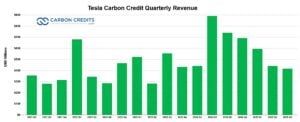
For years, these credits have provided Tesla with extra income. The company makes money by selling zero-emission vehicles. Then, it sells the credits to automakers that don’t meet emission standards.
Major buyers include Stellantis (formerly Fiat Chrysler) and General Motors. They use Tesla’s credits to reduce higher fleet emissions. In Europe, Toyota, Ford, Mazda, and Subaru have joined pooling arrangements linked to Tesla and other EV makers. These credit deals remain a key income source for Tesla, even as rival automakers expand their own EV lineups.
Between 2019 and 2024, Tesla made more than $11.8 billion in credit sales. But as other automakers launch more electric models, demand for Tesla’s credits is declining. Analysts say this trend will continue as the EV market matures and countries tighten credit systems.
However, expected revenues will gradually decline. This will happen as global manufacturers meet stricter carbon standards and depend less on external credits.
Tesla’s CFO noted that while carbon credit income still helps overall results, it is now a smaller part of the company’s total revenue. The company’s goal is to rely on vehicle and energy product sales instead of external credits in the long run.
ESG Edge: Tesla’s Ongoing Climate Impact
Tesla continues to lead in cutting transportation-related emissions through its EVs and renewable energy systems. In 2025, the company estimated that its global fleet helped avoid more than 20 million tons of CO₂ compared with gas-powered vehicles.
Its Gigafactories use renewable power where possible. For example:
- The Nevada Gigafactory sources most of its electricity from solar panels and nearby renewables.
- The Texas Gigafactory plans to reach 100% renewable electricity by 2026.
- The Berlin-Brandenburg Gigafactory uses energy from wind and solar farms in Germany.
In 2024, Tesla said its operations emitted around 1.6 million tons of CO₂-equivalent, mostly from manufacturing. However, it aims to reach net-zero operations by 2030, partly through on-site renewables and energy efficiency upgrades.
The company’s battery recycling program also expanded this year. Tesla said it processed over 10,000 tons of battery materials in 2025, recovering more than 90% of key metals such as nickel, lithium, and cobalt. This helps reduce both mining demand and production costs.
Market Reaction and Stock Outlook
Tesla’s stock traded lower after the Q3 results. Investors focused on shrinking profit margins and weaker credit income. Shares fell about 4% in after-hours trading following the announcement.
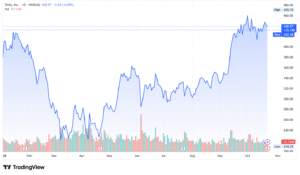
However, analysts noted that Tesla’s strong vehicle deliveries and growing energy business remain long-term positives. The company still holds about $29 billion in cash, giving it flexibility for new factory investments and product launches.
Tesla is also developing new products that could shape its next growth phase:
- Cybertruck deliveries are ramping up, with full-scale production expected in 2026.
- The next-generation “Redwood” compact EV is under development, targeting a lower-price market.
- The Dojo AI supercomputer continues to expand to improve autonomous-driving systems.
Analysts project that Tesla’s annual deliveries could reach 1.9 million units in 2025, up from 1.8 million in 2024. But the company must maintain cost control and increase battery supply to stay competitive.
Tesla remains the top global EV brand, but its market share is shrinking. Companies like BYD, Hyundai, Volkswagen, and GM are expanding fast. BYD alone sold over 3 million EVs in 2024, close to Tesla’s total deliveries.

Costs are another challenge. Prices for lithium and nickel, key battery metals, have been volatile. Benchmark Mineral Intelligence reported that lithium carbonate prices rose nearly 25% in early 2025 after a sharp fall in 2024.
Tesla is working to reduce these risks through in-house battery production and supply deals. It is also developing its “Optimus” robot and expanding its Full Self-Driving (FSD) software, which could bring new recurring revenue in the future.
Policy Shifts and the Carbon Economy
Tesla’s position in carbon markets is also tied to global climate policy trends. The federal EV tax credits ended in 2025 after new legislation. The change removed the $7,500 credit for many new EV buyers and the $4,000 used-EV credit.
This shift reduces a key buyer incentive in the U.S. and may affect EV demand and pricing going forward. Meanwhile, in Europe, new carbon border taxes could make manufacturing outside the region more costly.
Globally, voluntary carbon markets are growing by about 20% each year. However, regulators are pushing for stricter verification standards.
Tesla’s carbon credit decline fits a broader pattern—many automakers are now earning their own credits instead of buying them. The shift signals progress toward wider EV adoption but also limits a once-steady source of profit for Tesla.
Beyond Cars: Tesla’s Clean Energy Expansion
Beyond cars, Tesla’s energy division remains a major growth area. The company is scaling up battery-storage products like Powerwall for homes and Megapack for utilities.
In 2025, global installations of Tesla’s energy storage exceeded 40 GWh, up 16% year over year. These systems help stabilize power grids and integrate renewable energy.
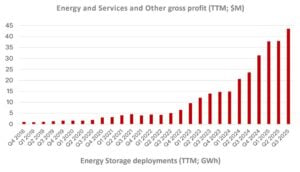
Tesla also said its solar installations reached 280 MW in the quarter, a 9% increase. Although still a small part of total revenue, solar and storage help diversify the business as the company moves closer to its clean-energy mission.
Looking forward, Tesla plans to:
- Increase battery recycling capacity by 50% by 2026.
- Expand Megapack production in California and China.
- Develop lower-cost energy products for homes and small businesses.
These steps aim to make Tesla not just an automaker but a full-scale clean energy company.
Bottom Line: Growth Meets Reality
Tesla’s Q3 2025 results show solid growth but shrinking profits. Vehicle deliveries set a new record, and the energy business expanded. Yet, weaker margins and falling carbon credit sales highlight growing challenges for Tesla.
From an ESG perspective, Tesla remains a major player in global decarbonization. Its EVs and clean energy systems continue to reduce emissions worldwide. But maintaining that leadership will depend on cost discipline, stable policies, and innovation in both batteries and AI systems.
As the company enters the final quarter of 2025, investors will watch closely for signs of margin recovery and progress on new product lines. The next few quarters will show whether Tesla can balance fast growth with profitability, while staying true to its sustainability mission.
FURTHER READINGS:
- Tesla (TSLA) Stock Rises Over $450, Hits Record $1.5T Market Cap as Q3 Delivery Test Looms
- Tesla’s AI5 Chip Challenges NVIDIA’s Dominance in AI Hardware Innovation
- Tesla Shifts From EVs to AI: Musk Says Robots Will be 80% of Company Value
The post Tesla (TSLA) Stock Slips After Q3 Results as Carbon Credit Revenue Plunges 44% appeared first on Carbon Credits.
Carbon Footprint
Amazon and Cascade SMRs: Redefining America’s Clean Energy for AI and Cloud Computing
Amazon is taking a bold step toward the next frontier of clean energy. In Washington state, the company is helping to build one of the United States’ first small modular reactor (SMR) facilities. This innovative nuclear energy project could redefine how big tech powers artificial intelligence (AI), cloud computing, and data centers.
The upcoming Cascade Advanced Energy Facility will be one of the first commercial SMR sites in the U.S. Developed by Energy Northwest and X-energy, this project represents a major milestone in the shift toward reliable, carbon-free energy for a rapidly digitizing world.
Bob Schuetz, CEO of Energy Northwest, said,
“Today marks a pivotal step forward in bringing this transformative project to life. We are proud to be at the forefront of deploying advanced nuclear technology in the region—driving next-generation solutions that strengthen energy security and position the Pacific Northwest as a clean energy leader.”

Cascade: The Nuclear Powerhouse Behind Amazon’s Digital Future
Amazon’s data centers are the digital backbone of modern life—running AI models, streaming services, and e-commerce systems that demand massive amounts of electricity. As power needs grow, traditional renewable sources like solar and wind alone can’t always meet 24/7 demand. That’s where nuclear energy steps in.
- The Cascade facility, located near Richland, Washington, will produce up to 960 megawatts (MW) of clean electricity using X-energy’s Xe-100 advanced reactor design.
The project will start with four SMRs generating 320 MW, with expansion plans for up to 12 units. Construction is expected to begin before 2030, with operations commencing in the early 2030s.
Kara Hurst, Chief Sustainability Officer, Amazon, commented:
“Seeing these renderings is truly inspiring, and a reminder that innovation and sustainability go hand in hand. This project isn’t just about new technology; it’s about creating a reliable source of carbon-free energy that will support our growing digital world. I’m excited about the potential of SMRs and the positive impact they will have on both the environment and local communities.”
Here’s a snapshot of the project site:

SMRs: A Smaller, Safer, and Scalable Future
SMRs represent the next evolution in nuclear energy. They’re designed to be smaller, safer, and faster to deploy than conventional reactors. The modular layout allows facilities like Cascade to scale as demand grows—making it a perfect match for AI-powered data centers that require continuous, high-capacity electricity.
Xe-100 Advanced Reactor Features
Each Xe-100 reactor will use a High-Temperature Gas-cooled Reactor (HTGR) and advanced fuel, improving safety and efficiency. The design minimizes the risk of overheating and eliminates the need for large water-cooling systems, which are standard in older nuclear plants.
Key advantages include:
- 80 MW per reactor module with a 60-year design life.
- Modular construction allows components to be built off-site and transported via rail or road.
- Continuous online refueling, reducing downtime, and increasing efficiency.
- Walk-away safe design with passive safety systems that eliminate the risk of overheating.
- Fuel that cannot melt, further enhancing safety.
Unlike traditional gigawatt-scale reactors that occupy vast tracts of land, Cascade’s compact design will fit on a few city blocks. Each SMR is modular, which means parts can be factory-built and assembled on-site, reducing costs and construction time.
The environmental advantage is clear: SMRs provide round-the-clock, carbon-free electricity without the intermittency challenges of solar or wind. This makes them a critical piece of the clean energy puzzle for tech-driven economies.
According to J. Clay Sell, CEO of X-energy, said
“The support of Amazon has enabled us to accelerate progress on our technology, grow our team, and position the Cascade Advanced Energy Facility at the forefront of energy innovation.”
Jobs, Training, and Local Benefits
Once the Cascade project is complete, the facility will create over 1,000 construction jobs and more than 100 permanent positions in nuclear operations, engineering, and technical maintenance.
To build a skilled local workforce, Columbia Basin College in Pasco, Washington, is developing an Energy Learning Center with a sophisticated Xe-100 control room simulator. Think of it as a flight simulator for nuclear operators.
The press release also revealed that the simulator will train future plant operators, engineers, and technicians in collaboration with Washington State University Tri-Cities and is set to open in late 2025.
This initiative, funded by the U.S. Department of Energy (DOE), provides students with hands-on experience in advanced nuclear technology—bridging the gap between classroom learning and real-world careers.
Amazon’s Growing Nuclear Portfolio
Amazon’s investment in Cascade is part of a broader strategy to diversify its clean energy sources. The company has already invested billions of dollars in carbon-free technologies, including nuclear power, through its Climate Pledge Fund.
This fund supports companies developing scalable solutions to decarbonize energy systems. Amazon’s capital investment in X-energy is expected to help bring over 5 gigawatts (GW) of new nuclear capacity to the U.S. grid by 2039—enough to power 3.8 million homes.
- In another move, Amazon signed agreements with South Korea’s Doosan Enerbility and Korea Hydro & Nuclear Power Co. to accelerate SMR deployment in the U.S. These partnerships are part of Amazon’s long-term strategy to integrate advanced nuclear into its clean energy mix.
- The company also teamed up with Talen Energy in Pennsylvania to develop a data center next to an existing nuclear plant, further securing access to reliable carbon-free power for its expanding cloud infrastructure.
Clean Energy Beyond Renewables
Amazon is the world’s largest corporate purchaser of renewable energy, with over 600 clean energy projects operating globally. It had already reached 100% renewable electricity worldwide—seven years ahead of its 2030 goal.
According to a DNV report, AI-focused data centers could require 10 times more power over the next five years. Meeting that demand will require a mix of renewables, nuclear, and other carbon-free technologies.
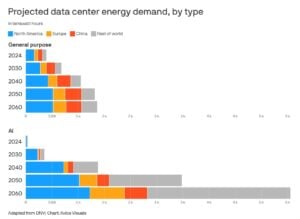
Amazon’s approach is clear: continue expanding renewable energy while also investing in stable, long-duration power sources like SMRs that can provide consistent baseload power. Nuclear energy complements renewables by filling the gaps when solar and wind output fluctuate.
Building the Energy Infrastructure of Tomorrow
The International Energy Agency (IEA) reported that global energy demand grew 2.2% in 2024, outpacing the decade’s average. Industrial activity now drives nearly 40% of global electricity use, and the rise of digital services and AI compounds this demand.
Amazon’s nuclear investments aim to meet this target. The Cascade project will not only add clean power to the regional grid but also strengthen the U.S. energy infrastructure and reduce reliance on fossil fuels.
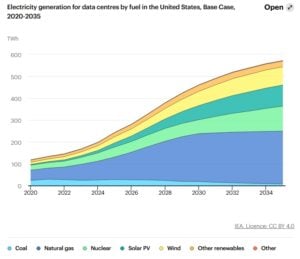
Beyond decarbonization, these efforts create economic opportunities for local communities through job creation, tax revenue, and the establishment of a clean energy supply chain in the Pacific Northwest.
Thus, from renewables to nuclear, Amazon’s energy strategy is redefining what it means for technology companies to lead in climate action. As the Cascade facility takes shape, it could become a model for how advanced nuclear energy powers the next phase of the global clean energy transition—fueling both innovation and sustainability, one reactor at a time.
- READ MORE: IAEA Predicts Doubling Nuclear Capacity by 2050—SMRs and Reactor Life Extensions Lead the Way
The post Amazon and Cascade SMRs: Redefining America’s Clean Energy for AI and Cloud Computing appeared first on Carbon Credits.
Carbon Footprint
Microsoft (MSFT) Buys 28,900 Tonnes of CO₂ Removal from UNDO in Landmark Multi-Million-Dollar Deal
Microsoft (NASDAQ: MSFT) has taken another major step toward its 2030 carbon-negative goal by expanding its partnership with carbon removal company UNDO. The tech giant has agreed to purchase 28,900 tonnes of permanent CO₂ removals, backed by an innovative financing structure from Inlandsis, a Canadian climate fund managed by Fondaction Asset Management.
The deal—estimated to be worth over $5 million based on current Enhanced Rock Weathering (ERW) credit prices—marks Microsoft’s third and largest purchase from UNDO to date.
It follows earlier commitments in 2023 and 2024, bringing the company’s total removals with UNDO to nearly 49,000 tonnes.
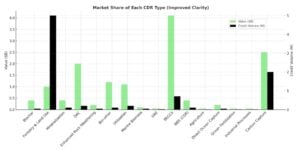
Financing the Next Frontier of Carbon Removal
To keep global warming below 1.5°C, the world must remove billions of tonnes of CO₂ from the atmosphere by mid-century. But achieving that scale requires more than promising technology. It demands financing structures that can fund large-scale deployment and reward verified results.
That’s where Inlandsis plays a crucial role. The fund has developed a first-of-its-kind debt financing model to fully support UNDO’s latest ERW project. The structure ensures that capital is deployed in sync with verified progress, effectively tying funding to real-world delivery.
UNDO’s CEO Jim Mann described the model as a turning point for the industry:
“Innovative financing is the catalyst for unlocking gigatonne-scale carbon removal. The support of Inlandsis shows how financial backers can help transform carbon removal into a genuine asset class, one that is scalable, tradable, and investable. By combining financial innovation, strategic partnerships and bleeding-edge science, UNDO is accelerating deployment and delivering both climate and agricultural benefits in Ontario and beyond.”
By blending financial innovation, strategic partnerships, and rigorous science, UNDO is proving that enhanced rock weathering can be both a credible carbon removal method and an investable business model.
Additionally, the company’s focus on transparent MRV (measurement, reporting, and verification) ensures that every credit sold is backed by evidence and durability.
Microsoft’s Evidence-Backed Commitment
Microsoft’s partnership with UNDO has evolved gradually but strategically—each stage built on verified outcomes and increasing scientific confidence.
- 2023: Microsoft made its first-ever ERW purchase with a 5,000-tonne agreement.
- 2024: The company followed up with 15,000 tonnes and additional funding to strengthen scientific measurement and monitoring.
- 2025: This latest deal for 28,900 tonnes represents the company’s largest ERW investment yet.
The steady growth signals Microsoft’s confidence in the integrity and scalability of enhanced rock weathering. It also reflects a shift in the carbon removal market, where buyers are moving from pilot projects to multi-year, performance-based partnerships.
Phillip Goodman, Director of Microsoft’s Carbon Removal Portfolio, underscored the importance of science-led delivery,
“Enhanced rock weathering is a promising pathway to gigatonne-scale carbon removal. UNDO’s commitment to scientific rigour gives us confidence in both the durability of these credits and their role in helping Microsoft achieve its goal of being carbon negative by 2030.”
For Microsoft, this approach ensures that every tonne purchased represents verified, durable removal—not speculative offsets. The company’s portfolio strategy emphasizes transparency, permanence, and continuous improvement.
READ MORE:
- Microsoft and UNDO Partner for 15,000 Tons of Carbon Removal Using Enhanced Rock Weathering
- Microsoft (MSFT Stock) Tops Q2 2025 Record-Breaking Surge in Durable Carbon Removal Credit Purchases
Backing UNDO: Insurance-Enabled, Bankable Carbon Solutions
For Inlandsis, the UNDO deal marks two significant milestones: it is the fund’s first ERW investment and its first Canadian project under its second climate fund. These achievements underscore how carbon finance is evolving—shifting from traditional offset models to evidence-backed removal financing.
David Moffat, Managing Director at Inlandsis, said the project highlights a new direction for climate investment:
“This strategic and innovative deal strengthens the growing relationship between Microsoft and UNDO while advancing the critical fight against climate change. It also reflects our commitment to financing credible, scalable carbon solutions in Canada and beyond.”
Adding another layer of security, the deal is underwritten by CFC, a specialized insurance provider for the carbon markets. CFC’s involvement de-risks the transaction by ensuring compensation if project milestones aren’t met—an emerging best practice in carbon finance.
Such insurance-backed financing is becoming a cornerstone for scaling carbon removal. It gives both investors and lenders the confidence to fund long-term projects, accelerating deployment and making climate solutions bankable.
A Replicable Model for the Carbon Market
This financing structure is designed to meet the needs of all players in the carbon ecosystem:
- Buyers like Microsoft get verified, durable credits with transparent evidence.
- Lenders gain confidence through milestone-based repayment tied to credit issuance.
- Farmers benefit from predictable, low-disruption operations that align with agricultural cycles.
By ensuring that capital flows only after verified results, the model turns projected tonnes into measured, issued removals. It’s a practical, transparent framework that can be replicated across regions and scales.
UNDO’s growing list of partners—Microsoft, Barclays, British Airways, and McLaren—illustrates strong corporate demand for high-integrity removals. Each new deal builds capacity for UNDO’s operations, allowing it to scale faster while maintaining scientific rigor.
Ground-Level Action: Every Rock, Every Acre, Every Record
Under the new agreement, UNDO will deploy 90,000 tonnes of crushed wollastonite, a calcium silicate rock, across 30,000 acres of Canadian farmland. The operation is designed to fit seamlessly within normal farming practices, using existing machinery and scheduled around planting and harvest.
The delivery process is transparent and data-rich:
- Equipment is calibrated and GPS-tracked.
- Every load of rock is logged and verified.
- Soil and porewater samples are collected at multiple intervals and analyzed in accredited labs.
- Each sample follows a strict chain of custody from field to lab to final data report.
These steps ensure that every credit issued represents real, measured carbon removal. UNDO’s system links field operations with verified outcomes, providing partners with full traceability from quarry to credit.
UNDO’s ERW process
Science-Led, Evidence-Based Removals
Enhanced rock weathering accelerates a natural process where CO₂ reacts with silicate minerals in rock, forming stable carbonates that lock away carbon for thousands of years.
UNDO’s science-first approach ensures that every aspect—from sampling design to lab analysis—is statistically sound and auditable. Sampling plans are written in advance for accuracy, include control plots, and specify precise locations and timing for collection.
Once samples are analyzed, results go through multiple quality control checks, and data are tied to GPS coordinates and timestamps. Life-cycle emissions from quarrying, transportation, and spreading are subtracted, and uncertainty margins are conservatively applied before credits are issued.
Issuance happens only after independent verification, meaning each credit represents net carbon removed, not just projected outcomes. This evidence-led methodology helps ensure transparency and credibility, both essential for scaling trust in the carbon market.
A Blueprint for Scalable Carbon Removal
This partnership between Microsoft, UNDO, and Inlandsis represents a powerful new model for how the carbon removal sector can grow. It combines long-term purchasing commitments, performance-linked finance, scientific validation, and insurance-backed assurance into one scalable framework.
The collaboration also offers a clear path for other companies and investors: pair proven carbon removal science with structured, delivery-based finance to accelerate real climate impact.
As UNDO expands operations, its combination of practical field deployment, scientific transparency, and financial accountability will serve as a blueprint for scaling carbon removal across geographies.
The next phase is focused on steady execution—planning rock supply, coordinating farm deployments, and sharing verified progress through public reporting. Each season adds data, strengthens methodologies, and builds confidence in the durability of ERW as a global climate tool.
The Surge in Verified Removals Signals Market Maturity
Microsoft’s (MSFT stock) $5 million partnership with UNDO is a signal of market maturity. It shows how science-based removal, innovative finance, and transparent delivery can work together to build a credible, investable carbon market.
Allied Offsets data showed that in the first quarter of 2025, around 780,000 CDR credits were contracted — a surge of 122% compared to the same period in 2024.
Additionally, 16 million credits were sold in the first six months of 2025 – marking it the strongest start to a year so far. The momentum is fueled by major buyers like Microsoft, aiming to be carbon negative by 2030. Also rise in biomass-based removal methods that are reshaping corporate offset strategies is contributing to the growth.
Market Highlights
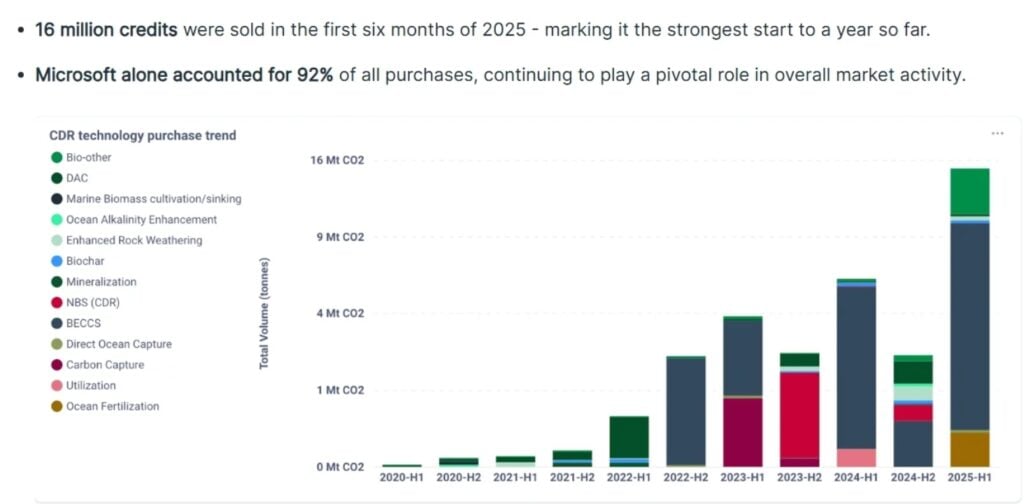
As the world races to reach net zero, this deal stands out as a real-world example of progress: a partnership that delivers measured, permanent carbon removal, financed and verified with integrity.
ALSO READ:
- Microsoft (MSFT) Signs $2.6 Million Soil Carbon Credit Deal with Agoro Carbon to Meet its Net-Zero Goals
- Microsoft Signs Groundbreaking 7MT Carbon Credits Deal with U.S.-Based Chestnut Carbon
The post Microsoft (MSFT) Buys 28,900 Tonnes of CO₂ Removal from UNDO in Landmark Multi-Million-Dollar Deal appeared first on Carbon Credits.
-
Climate Change2 years ago
Spanish-language misinformation on renewable energy spreads online, report shows
-
Climate Change2 months ago
Guest post: Why China is still building new coal – and when it might stop
-
Climate Change Videos2 years ago
The toxic gas flares fuelling Nigeria’s climate change – BBC News
-

 Greenhouse Gases1 year ago
Greenhouse Gases1 year ago嘉宾来稿:满足中国增长的用电需求 光伏加储能“比新建煤电更实惠”
-
Greenhouse Gases2 months ago
Guest post: Why China is still building new coal – and when it might stop
-

 Climate Change1 year ago
Climate Change1 year ago嘉宾来稿:满足中国增长的用电需求 光伏加储能“比新建煤电更实惠”
-

 Carbon Footprint2 years ago
Carbon Footprint2 years agoUS SEC’s Climate Disclosure Rules Spur Renewed Interest in Carbon Credits
-
Renewable Energy3 months ago
US Grid Strain, Possible Allete Sale

